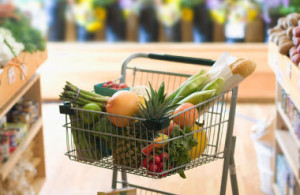As far as good-for-you foods go, the mind-boggling mix of advice directed to adults over the age of fifty is enough to make anyone’s head spin.

Photo by Thinkstock
Do you eat whole grains because the latest nutrition headlines say they prevent cancer? Become a vegan or vegetarian to help the heart? Honestly, eating advice for older adults changes depending on whatever research is making news.
That made us wonder, “Are there food staples that make it onto the weekly grocery list of health experts, regardless of headlines about ‘superfoods’?”
From doctors to scientists to dietitians, here’s a quick look at what six of the country’s top health experts are stashing in their shopping carts. Build these whole foods into your weekly shopping list and you’ll stay on the road to good health.
Top Food #1: Mushrooms
Dr. Dana Simpler, a primary care physician at Mercy Medical Center in Baltimore, MD, places special focus in her practice on using diet and lifestyle to prevent and reverse medical problems.
“One food I definitely eat each week is mushrooms, because mushrooms have strong anti-cancer properties and are also a great meat substitute in spaghetti sauce and soups,” Simpler says. “Mushrooms have an aromatase inhibitor effect, which reduces breast cancer occurrence and recurrence.”
Top Food #2: Dried Plums
“There’s some fascinating research on dried plums — prunes — and bone health,” says Leslie J. Bonci, director of sports nutrition at the University of Pittsburgh Medical Center for Sports Medicine and a nutrition consultant to the Pittsburgh Steelers.
“Dried plums are high in boron, a mineral that is important for bone structure, and high in polyphenols, plant nutrients that may have anti-inflammatory effects,” she says.
In addition, Bonci says scientists are looking at how eating prunes might improve bone mineral density. Of course, prunes are also nature’s best digestive aid. For seniors taking probiotics, these purple-black snacks are good prebiotics, special types of sugar or starches that feed and stimulate the growth of those good-for-your-gut probiotics.
Top Food #3: Unsalted Mixed Nuts
“I like crunchy textures, so chips are definitely my downfall,” admits registered dietitian Neal G. Malik, who specializes in chronic disease prevention and nutrition at the University of California, Riverside.
“To combat this craving, the one food I make sure I eat every week (if not every day!) are unsalted, mixed nuts. I love these as a post-workout snack! Just 1/4 to 1/2 cup provides a nice dose of heart-healthy fats, some protein, and a decent amount of fiber. They’re nature’s perfect food and they satisfy my cravings for crunch,” says Malik.
Top Food #4: Bananas
“Bananas are a favorite,” says Holley Grainger, a lifestyle and culinary nutrition expert who shares more than 700 healthy cooking and nutrition videos with her online audiences. When it comes to nutrition, “they’re an affordable fruit option that taste great, are filling and offer potassium, fiber, vitamin C, B6, and manganese.”
You can’t beat their versatility, either. “You can eat them as is or on peanut butter sandwiches, freeze and mix into smoothies, or use in baking,” she says. Even better, while bananas are helping older adults with blood pressure and heart health, they’re a healthy snack for the grandkids, too.
Top Food #5: Sweet Potatoes
Dr. Thomas Campbell, a longtime proponent of plant-based diets and author of the upcoming book, The Campbell Plan: The Simple Way to Lose Weight and Reverse Illness, Using The China Study’s Whole-Food, Plant-Based Diet, says he’s only recently come to appreciate sweet potatoes.
“Sweet potatoes have tremendous amounts of healthful nutrients, including antioxidants and minerals, in a package that’s full of long-lasting energy. It is a fairly low glycemic index food, causing a lower spike on blood sugar than white potatoes and many grains,” says Campbell.
Top Food #6: Leafy Greens
Mayo Clinic dietitian Katherine Zeratsky puts some form of leafy green in the grocery cart every week, usually romaine lettuce.
Romaine’s mild flavor and crunchy texture “allows me to dress it up with many varieties of foods – other vegetables, fruits, meats, cheese, nuts and seeds, to create combinations of savory or sweet dishes, not to mention make a balanced meal,” she says. “My cups of romaine are very low in calories yet an excellent source of potassium and vitamin A.”
Don’t like romaine? Zeratsky says to make it a point to choose favorite fruits and vegetables that are in season.
“Seasonality allows for better pricing and better quality,” she says. “I eat fruit at meals and as snacks, so there are always one or two bowls in the refrigerator. I have salad as an entrée or as a part of the meal several times per week, as it is a great way to get nutrients and fill up my stomach while keeping calories in check. Also, I add carrots, celery and onion to most meals, raw and cooked. It’s all just a great way to add flavor, fiber, and antioxidants.”
Related Articles
Healthy Eating: The Benefits of Farmer’s Markets
Shopping Solutions for Healthy Eating
Copyright© 2015 Next Avenue, a division of Twin Cities Public Television, Inc.
Check Out Our Blog for More Healthy Eating Tips
| With 133 years of experience, Bethesda has become a leader in senior care, offering independent living, assisted living, memory care, and skilled nursing. To see if memory care is right for your family, tour any of our communities, including Bethesda Dilworth, Bethesda Southgate, and Bethesda Hawthorne Place. After meeting with our residents and highly trained staff, you will instantly feel at home. |



